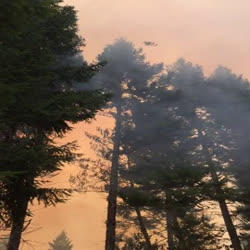
Jones Fire-INCIWEB
Just before American news reporters could excitingly begin covering the total solar eclipse from Oregon on Monday morning, they had to acknowledge the wildfire smoke caught by their cameras. “Wildfire Threatening the View” was one brief TV headline leading into the eclipse’s coverage. It was threatening a little more than that.
At least 600 residents of Milli, Oregon were forced from their homes due to a mandatory evacuation starting on Aug. 18. The Milli fire began Aug. 15 and has since burned nearly 7,000 acres just nine miles west of Sisters, a town in the path of the total solar eclipse, according to Central Fire Info.
Thanks to the once-in-a-lifetime event, the growing hazard received some much-needed national attention.
According to the National Interagency Fire Center, there are currently 43 active wildfires burning in the U.S., mostly in western states. With a growing number of residences and businesses expanding into wildfire-prone areas, the risk for injury and death is high. Between civilian and firefighter casualties and injuries, property damage and a host of other concerns, it seems like the potential losses outweigh most other reasons to fight them head on.
In response to the continuing threat of wildfires, experts and authorities have presented solutions that should not tempt mother nature too much.
Light Your Own Or Let It Burn
Controlled or prescribed burns are the preemptive technique that can decrease the likelihood of serious, hotter fires. They are fires started by authorities in strategic locations that eliminate dead trees and other conditions wildfires thrive on, and are easily extinguishable.
This method has been successful in certain parts of the U.S., such as Ohio, when in 2015 it played a critical role in maintaining healthy landscapes. Prescribed burns do present their own set of liability risks, however, with smoke’s effect on air quality and people’s health chief among them. Those and other environmental reasons influenced the nearly entire suspension of the practice in British Columbia in 2003. But the method has found a resurgence among B.C.’s firefighting authorities. A former Parks Canada controlled burn coordinator recently said that “people do not understand the benefits of burning,” and warned that suppressing a forest’s natural cycle, which includes fire, creates the conditions for mega-fires.
In a similar vein, the Los Angeles Times recently suggested letting the fires burn out to avoid firefighter casualties, citing statistics showing there is little that authorities can do once a fire has spread.
The New York Times echoed those sentiments, noting that some scientists have suggested redirecting funds from firefighting into projects that fireproof homes, which could better ensure community safety.
A 2016 report published by CoreLogic revealed that 1.8 million homes across 13 Western states are at extreme or high risk of wildfire damage. Additionally, according to ISO Mitigation 60% of all new housing units in the U.S. have been built on the edges of forests since 1999. With this data in mind, it might be time to invoke strategies that anticipate and harness wildfires rather than relying on reactive ones.
